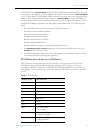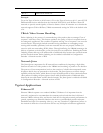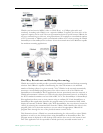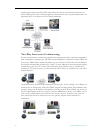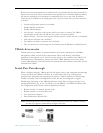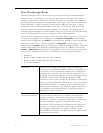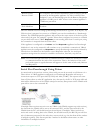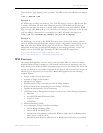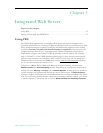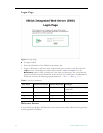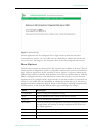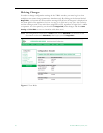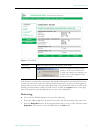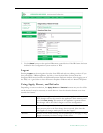
Streaming Video Basics
VBrick Appliance Getting Started Guide 31
This is how the "page flipping" effect is created. The URL to enter that will make this happen
is:
–File://./BB01/VB_1.HTM
Example 2
An HTML page or image can reside on a PC. Your PC must be set up as a Web Server. This
is actually easier than you think since Microsoft provides a PWS (Personal Web Server)
application that takes five minutes to install. Once installed you can place either an HTML
page or image (JPG, BMP, GIF, etc) into the web server directory (wwwroot) on the PC and
point the MPEG-2 browser to it. An example of a URL is that makes this happen is:
–http://172.16.3.148/image.jpg (example, use your own IP Address)
Example 3
An HTML page can reside on the WWW. You must enter a Gateway IP Address, primary
server IP Address and default domain extension in the Configuration: Network page on the
IWS. Note that many WWW HTML pages use java that the VBrick browser does not
understand. In this case the billboard will display an error message and may (or may not)
display some of the HTML page. Examples of URL's that make this happen are:
http://www.VBrick.com or http://www.yahoo.com
http://www.VBrick.com or /billboard/navigation.htm
WM Features
The VBrick WM Appliance converts analog video and audio from any source into digital
Windows Media streams. It attaches to your network and delivers the streaming video and
audio directly to any Windows Media-compatible player or server. The VBrick can deliver the
streams via multicast to any number of players on the network and it can serve the stream via
unicast to up to 200 players or servers. The VB6000 WM Appliance has the following
standard features:
• Accepts composite or S-Video input.
• Available as single or dual channel.
• Multiple bit rate support.
• Windows Media Video 9 encoding (bit rates 20 Kbps–4 Mbps).
• Windows Media Audio 8 encoding (bit rates 5 Kbps–192 Kbps).
• Optional 60 GB hard drive for local archiving.
• HTTP Push from a WM appliance reflector source to any of the following destinations:
•Multicast.
• Served HTTP and RTSP unicast (Pull)
•Archive to a File.
• HTTP Push.
• Multicast Streaming (UDP).
• Any combination of up to 200 clients including:
• Unicast RTSP Streaming (UDP).
• Unicast HTTP Streaming (TCP).
• Stream Push (25 maximum) to Microsoft Windows Media Server or RealNetworks
Helix Server via HTTP (TCP).
• Stream Pull from Windows Media Server or RealNetworks Helix Server via HTTP.



